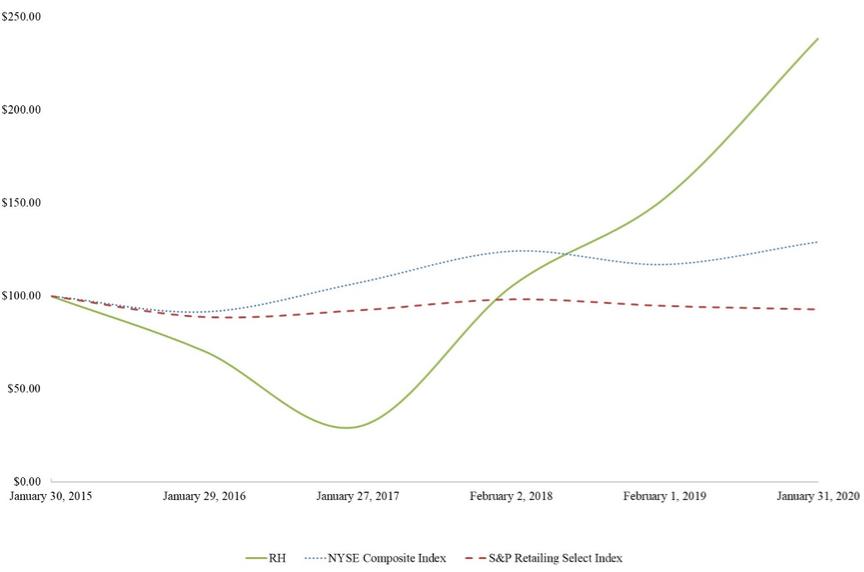other things: (a) address the processing of payments from insurance proceeds in connection with casualty or other insured losses with respect to property or assets of a Loan Party, and (b) add an additional category of permitted restricted payment to allow the lead borrower to make annual restricted payments of up to $3 million per fiscal year to cover payments of certain administrative and other obligations of RH in the ordinary course of business.
On April 4, 2019, Restoration Hardware, Inc., entered into a third amendment to the Credit Agreement (the “Third Amendment”). The Third Amendment, among other things, (a) established a $120.0 million first in, last out (“FILO”) term loan facility, which amount was fully borrowed as of April 4, 2019 and which incurs interest at a rate that is 1.25% greater than the interest rate applicable to the revolving loans provided for under the Credit Agreement at any time, (b) provided for additional permitted indebtedness, as defined in the Credit Agreement, that the loan parties can incur, and (c) modified the borrowing availability under the Credit Agreement in certain circumstances.
The Company repaid the full amount of the FILO term loan as of February 1, 2020. As a result of the repayment, the Company incurred a $0.8 million loss on extinguishment of debt in fiscal 2019, which represents the acceleration of amortization of debt issuance costs. The Company did not incur any prepayment penalties upon the early extinguishment of the FILO term loan.
On May 31, 2019, Restoration Hardware, Inc. entered into a fourth amendment to the Credit Agreement (the “Fourth Amendment”). The Fourth Amendment, among other things, amended the Credit Agreement to (a) extend the time to deliver monthly financial statements to the lenders for the fiscal months ending February 2019 and March 2019 until June 19, 2019, (b) remove the requirement to deliver monthly financial statements to the lenders for the last fiscal month of any fiscal quarter, and (c) waive any default or event of default under the Credit Agreement relating to the delivery of monthly financial statements or other information to lenders for the fiscal months ending February 2019 and March 2019.
The availability of credit at any given time under the Credit Agreement is limited by reference to a borrowing base formula based upon numerous factors, including the value of eligible inventory and eligible accounts receivable. As a result of the borrowing base formula, actual borrowing availability under the revolving line of credit could be less than the stated amount of the revolving line of credit (as reduced by the actual borrowings and outstanding letters of credit under the revolving line of credit). All obligations under the Credit Agreement are secured by substantially all of the assets, including accounts receivable, inventory, intangible assets, property, equipment, goods and fixtures of Restoration Hardware, Inc., Restoration Hardware Canada, Inc., RH US, LLC, Waterworks Operating Co., LLC and Waterworks IP Co., LLC.
Borrowings under the revolving line of credit are subject to interest, at the borrowers’ option, at either the bank’s reference rate or London Inter-bank Offered Rate (“LIBOR”) (or, in the case of the revolving line of credit, the Bank of America “BA” Rate or the Canadian Prime Rate, as such terms are defined in the Credit Agreement, for Canadian borrowings denominated in Canadian dollars or the United States Index Rate or LIBOR for Canadian borrowings denominated in United States dollars) plus an applicable margin rate, in each case.
The Credit Agreement contains various restrictive covenants, including, among others, limitations on the ability to incur liens, make loans or other investments, incur additional debt, issue additional equity, merge or consolidate with or into another person, sell assets, pay dividends or make other distributions, or enter into transactions with affiliates, along with other restrictions and limitations typical to credit agreements of this type and size. The Credit Agreement also contains various affirmative covenants, including the obligation to deliver notice to the First Lien Administrative Agent following the Company’s obtaining knowledge of any matter that has resulted or could reasonably be expected to result in a “Material Adverse Effect” (as defined in the Credit Agreement).
In addition, under the Credit Agreement, the Company is required to meet specified financial ratios in order to undertake certain actions, and the Company may be required to maintain certain levels of excess availability or meet a specified consolidated fixed-charge coverage ratio (“FCCR”). Subject to certain exceptions, the trigger for the FCCR occurs if the domestic availability under the revolving line of credit is less than the greater of (i) $40.0 million and (ii) 10% of the lesser of (x) the domestic revolving commitments under the Credit Agreement and (y) the domestic revolving borrowing base. If the availability under the Credit Agreement is less than the foregoing amount, then Restoration

